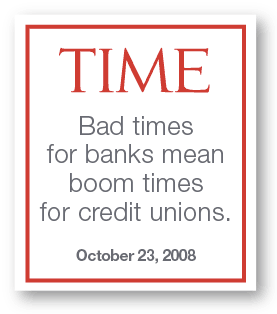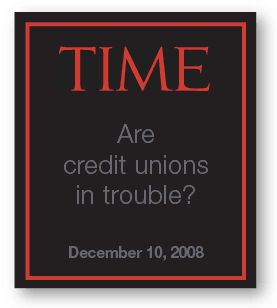“Credit unions have
joined the long line
of bailout recipients.”
— NPR’s Marketplace
For the past few months, the mainstream media had been heaping mounds and mounds of glowing press on credit unions. But last week, the TARP got thrown on credit unions and what happened? Poof! The good news is gone, and now articles with a much more somber, sober tone have taken their place.
Take this example from Time magazine. There’s a stark contrast in these two Time articles, one from late October and the other from mid December. The first article is markedly upbeat, where a playful picture accompanies a glowing story about credit unions:

Their latest article is much more dour:

NPR’s nightly business show Marketplace chimed in with a similar slant: “Credit unions have joined the long line of bailout recipients.”
What makes this particularly newsworthy is that the mainstream media basically never runs a story about credit unions — ever — much less outlets with the prestige of Time and NPR.
The details of the credit union TARP plan itself are actually quite clever and creative, if not a little complex. The way it works is that corporate credit unions get $41 billion. The corporates will lend this sum to their members, “natural person credit unions,” who will turnaround and deposit the borrowed money back with the corporates. It’s fancy accounting footwork that supposedly doesn’t cost taxpayers anything…that is, except for some confidence in the credit union system.

Navigating the Role of AI in Financial Institutions
83% of FI leaders agree investing in AI is essential for 2024 but how you leverage AI is instrumental in success and meeting customer expectations.
Read More about Navigating the Role of AI in Financial Institutions

Navigating Credit Card Issuing in an Uncertain Economic Environment
Build a modern credit card strategy that balances profitability and risk, adopts the latest technology and delivers the customization that cardholders demand.
Read More about Navigating Credit Card Issuing in an Uncertain Economic Environment
Reality Check: It doesn’t matter that corporate credit unions are the ones directly receiving TARP funds. The news media doesn’t care. The story is too complicated to explain. Paraphrasing, reporters will sum it up this way: “Credit unions are getting bailout money.”
The credit union TARP scheme is somehow supposed to generate interest-income along the way. The interest is to be matched by credit unions, who will use the money to lower mortgage payments for distressed members. This plan to recalculate mortgages raises some big questions:
- Who gets their mortgage reduced? How are they chosen?
- How do people qualify?
- How many people will this money really end up helping?
Key Fact: 36% of mortgages modified in Q1/08 had a 36% redefault rate after 3 months. 53% redefaulted after 6 months. [Source: CNBC]
Just the same, that isn’t the side of the story that the news media is likely to report.







